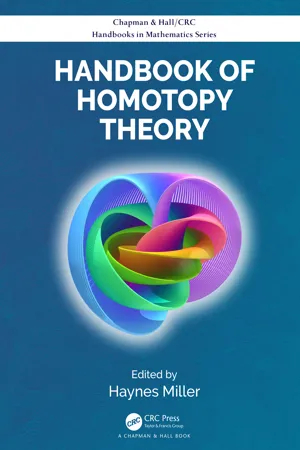
- 982 pages
- English
- ePUB (mobile friendly)
- Available on iOS & Android
Handbook of Homotopy Theory
About this book
The Handbook of Homotopy Theory provides a panoramic view of an active area in mathematics that is currently seeing dramatic solutions to long-standing open problems, and is proving itself of increasing importance across many other mathematical disciplines. The origins of the subject date back to work of Henri Poincaré and Heinz Hopf in the early 20th century, but it has seen enormous progress in the 21st century. A highlight of this volume is an introduction to and diverse applications of the newly established foundational theory of ¥ -categories.
The coverage is vast, ranging from axiomatic to applied, from foundational to computational, and includes surveys of applications both geometric and algebraic. The contributors are among the most active and creative researchers in the field. The 22 chapters by 31 contributors are designed to address novices, as well as established mathematicians, interested in learning the state of the art in this field, whose methods are of increasing importance in many other areas.
Frequently asked questions
- Essential is ideal for learners and professionals who enjoy exploring a wide range of subjects. Access the Essential Library with 800,000+ trusted titles and best-sellers across business, personal growth, and the humanities. Includes unlimited reading time and Standard Read Aloud voice.
- Complete: Perfect for advanced learners and researchers needing full, unrestricted access. Unlock 1.4M+ books across hundreds of subjects, including academic and specialized titles. The Complete Plan also includes advanced features like Premium Read Aloud and Research Assistant.
Please note we cannot support devices running on iOS 13 and Android 7 or earlier. Learn more about using the app.
Information
Table of contents
- Cover
- Half Title
- Series Page
- Title Page
- Copyright Page
- Contents
- Preface
- 1. Goodwillie calculus
- 2. A factorization homology primer
- 3. Polyhedral products and features of their homotopy theory
- 4. A guide to tensor-triangular classification
- 5. Chromatic structures in stable homotopy theory
- 6. Topological modular and automorphic forms
- 7. A survey of models for (∞,n)-categories
- 8. Persistent homology and applied homotopy theory
- 9. Algebraic models in the homotopy theory of classifying spaces
- 10. Floer homotopy theory, revisited
- 11. Little discs operads, graph complexes and Grothendieck–Teichmüller groups
- 12. Moduli spaces of manifolds: a user’s guide
- 13. An introduction to higher categorical algebra
- 14. A short course on ∞-categories
- 15. Topological cyclic homology
- 16. Lie algebra models for unstable homotopy theory
- 17. Equivariant stable homotopy theory
- 18. Motivic stable homotopy groups
- 19. En-spectra and Dyer-Lashof operations
- 20. Assembly maps
- 21. Lubin-Tate theory, character theory, and power operations
- 22. Unstable motivic homotopy theory
- Index